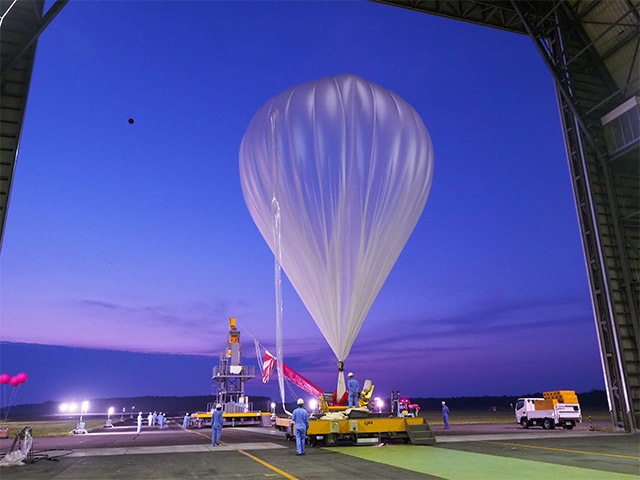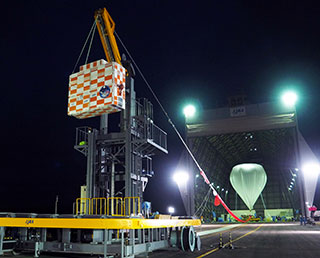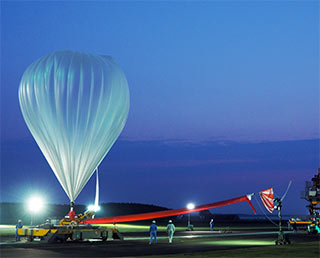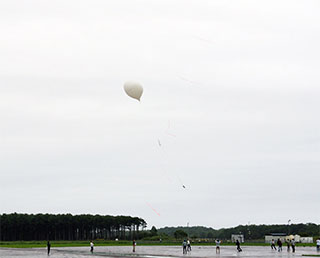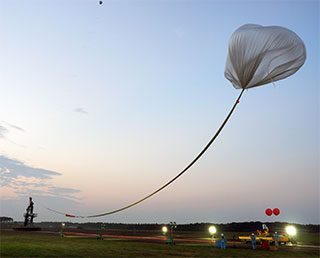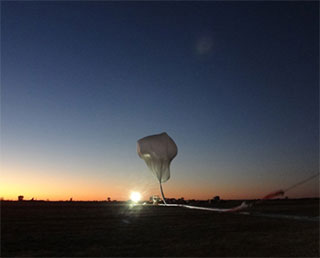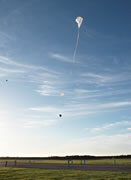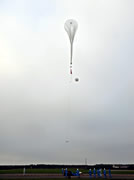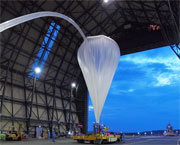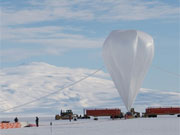Jun. 26, 2017 Updated
B17-04 Scientific Balloon Testing
On June 24, 2017, at 3:33 a.m. JAXA launched B17-04, the second of the first series of Japanese fiscal 2017 balloon tests. When fully deployed, a 5,000-cubic-meter aerostatic balloon extends a 23-meter diameter. Built with new load tapes*, B17-04 was released from the Taiki Aerospace Research Field and ascended at 330 meters/m. JAXA is granted use of the Taiki Aerospace Research Field based on JAXA—Taiki-cho collaboration initiative.
Hour and a half after the launch, B17-04 reached the float altitude of 24 kilometers above the Pacific Ocean, approximately 50 kilometers east of the Research Field. At 6:09 a.m., following the separation command the balloon and control equipment started descent, and fell at a point 20 kilometers south east off the origin of flight, offshore the Pacific Ocean. Then by 6:50 a.m. pickup was done by a ship that JAXA dispatched to the site.
At the time of B17-04 deployment, it was clear; wind speed 1.5 meters/s; temperature 11.7 C.
*Load tapes, inserted vertically/meridionally along the sealing lines of adjacent gores serve as the skeleton of a scientific balloon. To sustain a heavy payload in Earth’s stratosphere lying over 30 kilometers up from the ground, fibers of a load tape must provide ample reinforcement and low extensibility. Prior to this test, JAXA had used tapes made by foreign manufacturers. For B17-04 flight, a new, light weight Japanese-made product has been adopted for the first time.
|
|
Jun. 23, 2017 Updated
B17-02 Scientific Balloon Test
On June 23, 2017, at 4:47 a.m. JAXA launched B17-02, the first scientific balloon of the series of Japanese fiscal 2017 balloon test operations. The balloon was set aloft from the Taiki Aerospace Research Field, premises that JAXA uses based on JAXA—Taiki-cho collaboration initiative. The objective is capturing sampling of stratospheric microorganisms.* A giant scientific balloon 30,000 cubic meters in maximum volume, 42 meters in radius of the circular cross-section, rose approximately at 330 meters/m.
1.5 hours after the launch, B-17-02 hit the float altitude of 28 kilometers, approximately 40 kilometers east south-east of the Research Field. At 6:50 a.m., both the balloon and the devices for sample retrieval, cut off by a separation signal, dropped in the Pacific Ocean 15 kilometers south east of the Research Field. By 7:40 a.m., JAXA sent a ship to the landing spot and the salvage was completed.
At B17-02 launch, it was cloudy; wind speed 1.5 meters/s; ground temperature 15.5 C.
*Some reports have been made that collected stratospheric and mesospheric samples, proving that microorganisms exist in those layers of the Earth’s atmosphere. JAXA believes acquiring knowledge of the species and distribution of microbes high up in the atmosphere provides scientific insight into the upper edge of the biosphere. In B17-02 test operation, using the parachute, the attached apparatus obtains microbiological sampling as it descends through the atmosphere. Collected particulate and microbiological samples will go through detailed analysis.
|
|
Jun. 14, 2016 Updated
Scientific balloon B16-01 experiment completed - High altitude flight test for Mars probe airplane
JAXA conducted the second balloon release of the first scientific balloon experiment in JFY 2016 on June 12 (Sun.), 2016, aiming at a high-altitude flight test for a Mars probe airplane.
The balloon was released at 3:33 a.m. on the 12th from the Taiki Aerospace Research Field, which is a base for cooperation between the host town Taiki. The balloon entered in a state of horizontal floating at an altitude of 36 km over the Pacific Ocean some 45 km east from the Taiki Field at two hours and 25 minutes after its release. At 6:20 a.m., a radio command was sent to detach the test plane. Four minutes later, the balloon and a control instrument were also detached by the command, and they landed softly on the ocean about 35 km east from the Taiki Field. They were recovered by a boat at 7:04 a.m.
Concerning the flight test for a Mars probe airplane, we missed data for some part of the flight, but we will analyze the acquired data in detail for our future research.
With the test this time, we completed the first scientific balloon experiment. We would like to express our deep appreciation to all pertinent people and organizations for their cooperation.
* To achieve a Mars probe airplane, it is imperative to perform aerodynamic design of the plane to fit it for flight in the very thin atmosphere of one hundredth compared to that on the Earth. We conducted the test this time at a high altitude where we can simulate the Mars’ atmospheric density to acquire aerodynamic data for the plane. We will further analyze various data acquired from the test to incorporate the analysis results into future Mars probe airplane designs.
|
|
Jun. 8, 2016 Updated
Scientific balloon experiment B16-02 to capture microorganisms in the stratosphere
JAXA released the first scientific balloon in Japan Fiscal Year 2016 from the Taiki Aerospace Research Field, which is a base for cooperation between the host town and JAXA, at 3:43 a.m. on June 8 (Wed.), 2016. The purpose of this experiment is to capture microorganisms in the stratosphere. The balloon used this time is a large-size one with a maximum expansion volume of 15,000 cubic meters (33.5 meters in diameter), and it ascended at a speed of 300 meters/minute.
The balloon entered in a state of horizontal floating at an altitude of 28 km over the Pacific Ocean some 35 km east from the Taiki Aerospace Research Field at one hour and 40 minutes after its release. At 5:50 a.m., the balloon and an instrument to collect microorganisms were detached by a radio command and they landed softly on the ocean about 30 km east from the Taiki Field. They were recovered by a boat at 6:28 a.m.
|
|
Aug. 24, 2015 Updated
Scientific balloon experiment BS15-07 and completion of the first series of balloon experiments in JFY2015
JAXA released the balloon “BS15-07” from the Taiki Aerospace Research Field at 5:02 a.m. on Aug. 22 (Sat.), 2015, aiming at verifying onboard instruments and operation of the satellite “EGG”*, which will be deployed from the International Space Station (ISS). The balloon was 11 meters in diameter when it was fully expanded, and it was ascending at a speed of about 380 meters per minute.
The weather balloon reached an altitude of 31.7 km over the Pacific Ocean at about 55 km east north east from the Taiki Field. The test object was slowly descending by a parachute and splash-landed at 95 km east north east from the Field. With this experiment, we completed the first series of balloon experiments in JFY 2015. We would like to express our profound appreciation to all pertinent parties who have supported the experiments.
|
|
Aug. 7, 2015 Updated
Completion of Scientific balloon experiment BS15-03
JAXA released the balloon "BS15-03" from the Taiki Aerospace Research Field at 4:12 a.m. on Aug. 6 (Thu.), 2015, for the purpose of cryogenic sampling in the atmosphere at the stratosphere. The volume of the balloon when it was fully expanded was 100,000 m3 (with a diameter of 63.4 m), and it was ascending while gathering the atmosphere of the stratosphere.
The balloon reached an altitude of 34.8 km over the Pacific Ocean at about 50 km east from the Taiki field in three hours, then it was in a state of horizontally floating. At 7:49 a.m., the balloon and observation instrument was detached by a command radio wave to slowly descend to the ocean at about 30 km south east of the field. They were retrieved by a boat before 8:30 a.m.
|
|
May 15, 2015 Updated
Scientific balloon experiment in Australia
On May 12, JAXA conducted a scientific balloon experiment in cooperation with
some universities including Kobe University and Nagoya University from the balloon release base of the University of New South Wales, Australia.
The experiment aims at elucidating the spatial structure of a celestial body and the gamma-ray emission mechanism by attaining high resolution
observations using the emulsion gamma-ray telescope of Kobe and Nagoya Universities.
The balloon was released at 6:03 a.m. on May 12 (Japan Standard Time), and landed at 8:25 p.m. on the same day.
|
|
Sep. 9, 2010 Updated
Scientific balloon experiment BS10-06 completed
At 5:38 a.m. on September 8, 2010, JAXA released the fourth balloon of the second balloon experiment in Japan Fiscal Year 2010 from the Taiki Aerospace Research Field, the base of the collaborative work. The release experiment, called BS10-06, aimed at testing the high-altitude thin film balloon flight performance and observing the ozone and atmospheric gravitational waves. The balloon that was expanded to its full capacity of 60,000 m3 was made of a thin film for high altitude with a thickness of 3.4 micrometers, and it ascended about 300 meters per minute.
In this experiment, we achieved the scheduled objectives of flight verification for a thin-film high-altitude balloon using the polyethylene thin film that is wider than conventional films, and the balloon's tearing mechanism for a thin-film balloon. At the same time, the balloon carried out precise observations on the ozone, wind velocity, temperature and air pressure using two kinds of ozone measurement devices -- an optical type and electrochemical type (ECC,) -- to observe the ozone's altitude distribution and atmospheric gravitational waves between the near ground area and the upper stratosphere. Both the high-precision ECC ozonesonde and the precision optical ozonsonde functioned properly at an altitude of less than 30 km and higher than 30 km respectively, and we successfully observed the upper stratospheric regions at an altitude of 46.8 km.
We were able to acquire enough data to study changes in the ozone and atmospheric gravitational waves over years and places by comparing the data from this experiment with the first data acquisition at the Taiki Aerospace Research Field, and past observation results acquired at the Sanriku Balloon Center.
|
|
Aug. 30, 2010 Updated
Scientific balloon experiment B10-03 completed
At 5:41 a.m. on August 27, 2010, JAXA released the second balloon of the second balloon experiment season in JFY 2010 from the Taiki Aerospace Research Field, the base of the collaborative work. The release was part of the B10-03 experiment which aims at flying a bale (or a straw rice bag) shaped balloon. The balloon that was expanded to its full capacity of 5,000 m3 ascended 250 meters per minute.
The balloon reached an altitude of 25.2 km above the Pacific Ocean about 90 km east-north-east of the Taiki Aerospace Research Field in one hour and 45 minutes after the release, and the pressure inside the balloon, which was fully inflated by then, became higher than the atmospheric pressure. However, the film tore at the lower part of the balloon and the inside pressure was not maintained when the pressure difference between the inside and the outside reached 64 Pa at 7:25 a.m. while the inside pressure was increasing.
The main purpose of this experiment and research is to develop a bale shaped pressurized balloon whose air resistance is one digit lower than a conventional zero-pressure balloon due to its shape in order to realize the power balloon whose flight trajectory can be controllable at a future altitude of some 35 km. In this experiment, we used a smaller model of 5,000 m3 at full capacity volume, and confirmed the expansion process till full deployment under the stratospheric environment. We have also verified the movement of the balloon rupture mechanism of a pressurized balloon. The balloon film was actually torn at the lower pressure difference than we expected, thus we would like to study the reasons why the internal pressure was not maintained by investigating the pressure difference record and image data of the balloon deployment process, then incorporate the study results into future research and development.
|
|
Aug. 23, 2010 Updated
Scientific balloon release experiment B10-02 completed
At 5:12 a.m. on August 22, 2010, the B10-02 balloon, which aims to acquire cryogenic samples from the stratospheric atmosphere, was released from the Taiki Aerospace Research Field, the base of the first collaborative work for the second balloon experiment session in JFY 2010. The B10-02 is a large balloon with a full expansion volume of 100,000m3. It was ascending while taking samples from the stratospheric atmosphere.
The purpose of this experiment is to acquire a large volume of samples by solidifying the stratospheric atmosphere through a cryogenic method using liquid helium. The sample air will be provided to measure the concentration and isotopic ratio of various atmospheric contents including greenhouse effect gases. Acquisition of the stratospheric atmosphere was carried out between 14.6 km and 30.0 km in altitude while the balloon was ascending, during its horizontally floating, and at an altitude between 33.8 km and 28.3 km while descending. We successfully collected 12 sample containers of air in total from different altitudes.
The samples will be analyzed using cutting-edge analysis devices at participating institutions including Tohoku University, Tokyo Institute of Technology, Miyagi University of Education and the National Institute of Polar Research.
(Photo: Helium gas is loaded onto the balloon at JAXA's hangar.)
|
|
Aug. 17, 2009 Updated
BESS-Polar project receives NASA Group Achievement Award
The Balloon-borne Experiment with a Superconducting Spectrometer (BESS-Polar) project received the NASA Group Achieving Award. The project aimed at observing cosmic particles using a superconducting spectrometer installed on a balloon that circulated around the Antarctic. The first experiment was carried out in 2004, and a balloon circled above the Antarctic observing cosmic particles and rays. After the first experiment, the observation device was upgraded, and between December 2007 and January 2008, the second experiment was conducted. The balloon launched from the U.S. MacMurdo Base made almost two cycles above the Antarctic taking about 30 days, and observed 4.7 billion cosmic ray phenomena. Among them, the experiment detected over 8,000 phenomena of low-energy cosmic ray antiproton. The award this time was given for the development of the BESS-Polar observation device, which led to the global-leading investigation method of cosmic antimatter, and the successful 30-day balloon project.
(Photo: The release of the balloon)
|
|
